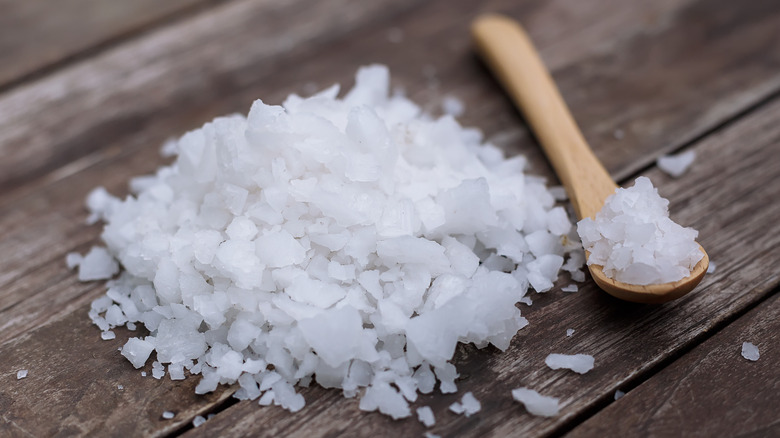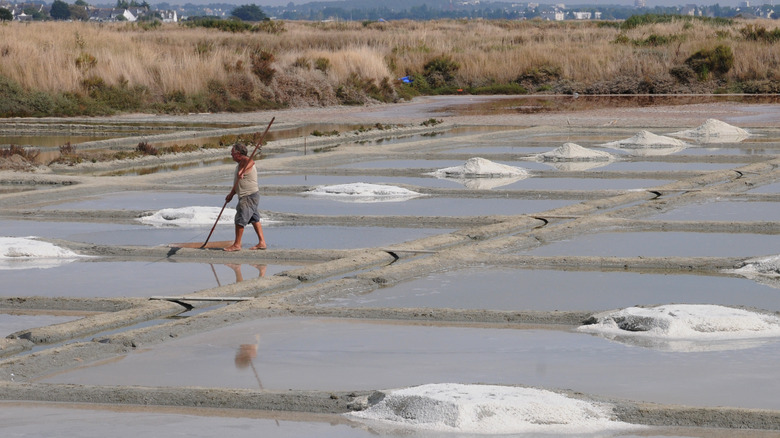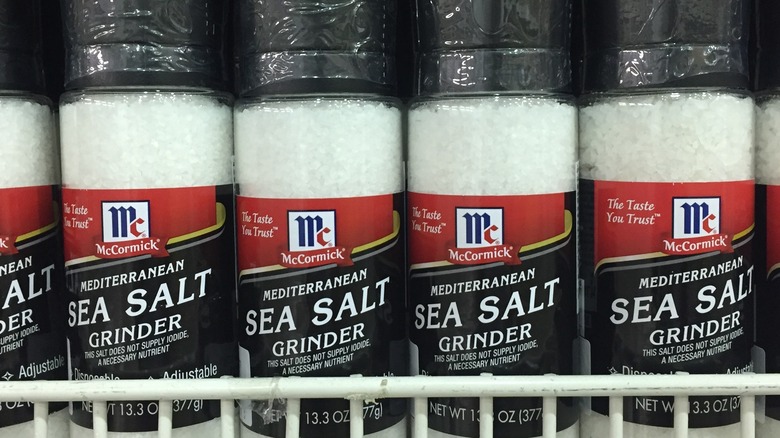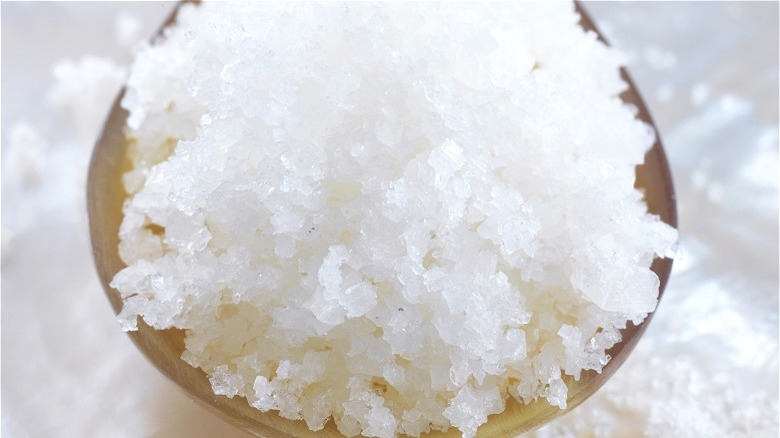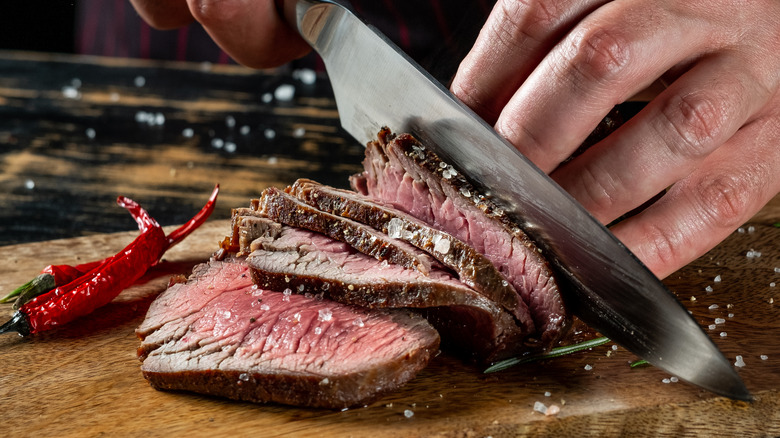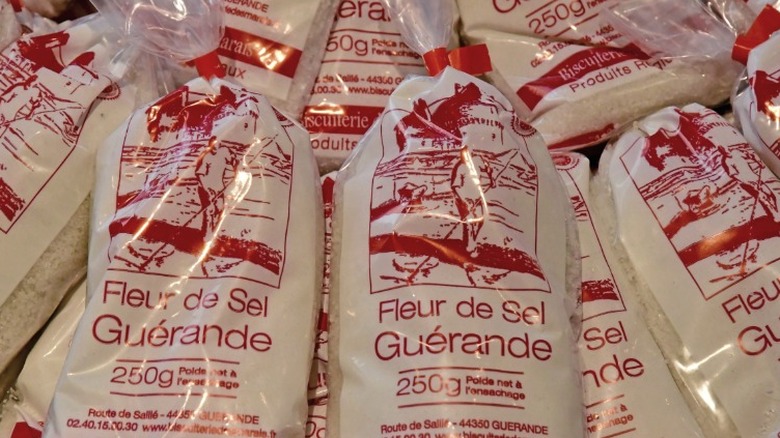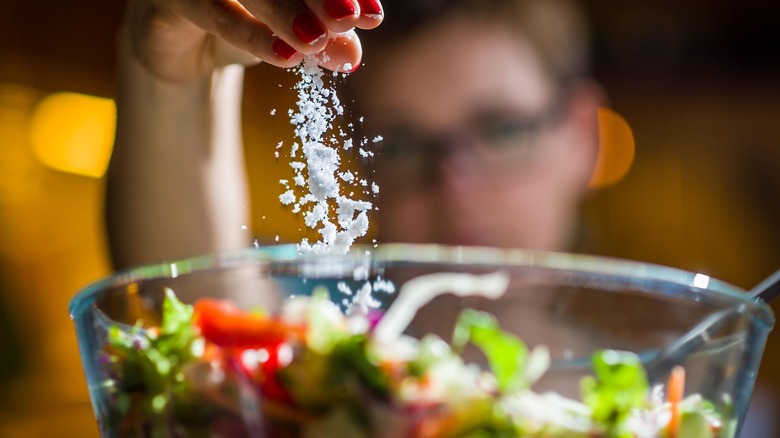What Is Fleur De Sel And Why Is It Special?
When it comes to the world of spices and seasonings, salt is the most basic, and the one most likely to be found in nearly every home kitchen. Of course, when we talk about basic salt we mean is the extremely fine, often iodized stuff that's found in tall blue canisters, paper to-go packets, or in the sticky shakers on restaurant tables. There's nothing basic, however, about the salt known as fleur de sel.
Pronounced "fleur-de-SELL" according to The Spruce Eats, the French name translates to "flower of salt." A special type of sea salt from France, the way it's harvested is what makes fleur de sel so unique. Much of the world's salt is mined from underground deposits using varying methods but which are by and large done with the help of machines. In contrast, fleur de sel is hand-harvested with traditional, more labor-intensive methods, and has a texture and flavor all its own. It's time to graduate from regular table salt and learn more about delicate fleur de sel.
This is where fleur de sel comes from
Authentic fleur de sel commands a high price and because of this food, writer David Lebovitz shares that some producers will deceitfully use the term on other salts as a marketing tactic. True fleur de sel, however, comes from Guérande, France in the Brittany region along the west coast where it's been gathered in the same way since the ninth century. Along with the region, the other aspect that denotes authentic fleur de sel is that it's harvested by hand, with no machinery involved until it's time to package the salt for sale. The process depends on ocean water that collects in marshes near the coast. Workers move the saltwater by hand through a chain of smaller and smaller marshes, removing any unwanted debris or critters in the process, until the water reaches shallow collection areas. The water is left there to begin evaporating, and as it does the salt is left behind. A thin crust of white salt on the surface of the water is painstakingly removed so no sediments below it are disturbed. This clean, pure salt is the true fleur de sel.
There's also a second type of salt gathered from these marshes: The salt that sits below the surface of the water resting against the clay-heavy soil. This gray salt is sold as sel gris or sel Guérande.
What's the difference between sea salt and fleur de sel?
The Kitchn shares that, technically speaking, all the salt we use is sea salt because even the salt mines located on land were formed by ancient, dried-up bodies of saltwater. While that's a fun bit of trivia, sorting out the differences between salt varieties is confusing enough without throwing this into the mix!
It's easy to find sea salt at most grocery stores, but there is a difference between these and the true fleur de sel. The salt you buy at the store that's labeled as sea salt is produced by allowing saltwater to evaporate and collecting the salt that stays behind. This process sounds similar to that of fleur de sel, but the difference is that trucks and other machinery are used to rake the salt deposits out of the water. The salt then has to be washed and refined to remove debris and contaminants before it can be packaged and sold. It tends to be more coarse than table salt and is also free of additives like iodine.
Fleur de sel is a special kind of sea salt because it's harvested in Guérande and only by hand using traditional techniques to move the water into marshes and to collect the salt that forms there. This slower and more intensive process, as well as the French provenance, is why authentic fleur de sel is more expensive than other sea salts.
What does fleur de sel taste like?
The company Brittany Sea Salt calls fleur de sel "the caviar of salt." Their careful harvesting method works only under the most optimal weather conditions. Therefore, the yield is small. The amount of fleur de sel each year is sought-after, treasured, and expensive. It's used sparingly to finish a dish where the texture and flavor can be enjoyed to the fullest.
It's strange to think that moisture could be a desirable thing for salt (in fact, restaurants drop grains of rice into salt shakers to wick away excess moisture,) but The Spruce Eats shares that a package of fleur de sel has a high amount of moisture from the seawater where it's harvested: Much more moisture than in other salts — and that's a good thing! This moisture gives the salt a "briny" taste of the ocean and helps the crystals gather on your tongue so that the flavor is more perceptible. In contrast to finely ground regular table salt, fleur de sel has a coarser texture with large crystals. This is another reason why it's nice to sprinkle over the tops of finished dishes where the crystals can be appreciated visually, as well as tastily.
The best way to use fleur de sel
Several characteristics make fleur de sel a standout from other sea salts or table salt: the history and hand-harvesting techniques that go back over 1,100 years in Guérande, France, the delicate, briny flavor, and the high price tag, (according to food writer David Lebovitz). For these reasons, fleur de sel is rather, precious and cooks use it sparingly to make it last as long as possible. So don't reach for fleur de sel for pre-salting foods or to make a batch of pickles! Instead, treat it like a finishing salt that you can use to garnish dishes right before eating.
Try sprinkling fleur de sel over green salads or slices of fresh fruit. The Spruce Eats likes using the delicate salt on homemade soft pretzels or to make salted caramel candies. It's also delicious with simply prepared seafood dishes like pan-fried fish or scallops, and to enhance the flavor of fresh summer tomatoes, according to Fine Cooking. The flaky texture of salts like fleur de sel is King Arthur Baking's choice for sweets like chocolate chip cookies or dark chocolate brownies. Sous Chef recommends fleur de sel to top a juicy steak hot off the grill, or to use it as the Britons do to garnish buckwheat crepes. It's also nice to sprinkle over pieces of crusty bread dipped in olive oil.
Here's where to find fleur de sel
Now that we've convinced you that fleur de sel is a special salt that belongs in your spice cabinet, you might be wondering where to find it. Well, if you have a trip to France, planned in the near future, bring along an extra suitcase so you can bring plenty of fleur de sel home with you! Food writer David Lebovitz shares that while more expensive than regular table salt, fleur de sel costs less per pound in France than sources outside of the country. This makes sense considering that it's sourced there and French salt sellers don't have import or export costs to pass on to local customers.
If jetting to France isn't an option, The Spruce Eats shares that the salt can be found at online sellers including Amazon, Williams-Sonoma, and European foods stores like Yummy Bazaar. You may also find fleur de sel at stores in your area that specialize in spices or international foods. Lebovitz notes that the truly authentic salt comes from Guérande, France. (Although sea salts from other areas of the country are sometimes labeled as fleur de sel.) When it's genuine, the bag or container will have "Guérande or Guérandais prominently noted along with the words fleur de sel." Remember, too, that sel gris or gray sea salt also comes from Guérande, but the difference is easy to spot: sel gris is gray and fleur de sel is pure white.
Is fleur de sel more nutritious than regular salt?
Flavor and provenance make fleur de sel special, and because it's harvested naturally with so much care, many wonder if this salt has health benefits as well. Healthline shares that one way that sea salts like this are the same as other salts is that they consist of sodium chloride. Because fleur de sel doesn't get washed or refined like table salt and generic sea salt it also contains more naturally occurring nutrients, including iron, potassium, and bone-building calcium. However, these nutrients are present in such tiny amounts that you won't get the benefit of them unless you eat a very large amount of fleur de sel — and excessive salt consumption carries health risks, like high blood pressure and heart disease, that outweigh the benefits.
Another difference between fleur de sel and regular table salt is that the crystals are larger, so they measure out differently: There are only 4.2 grams of sodium in a teaspoon of the sea salt compared to 6.1 grams for regular table salt. On the one hand, this means you would need more fleur de sel to match the saltiness of the same amount of table salt. However, fleur de sel isn't meant for cooking or baking use but as a garnish to sprinkle over finished dishes, so you'll get to taste the larger, briny crystals with each bite of your food.
